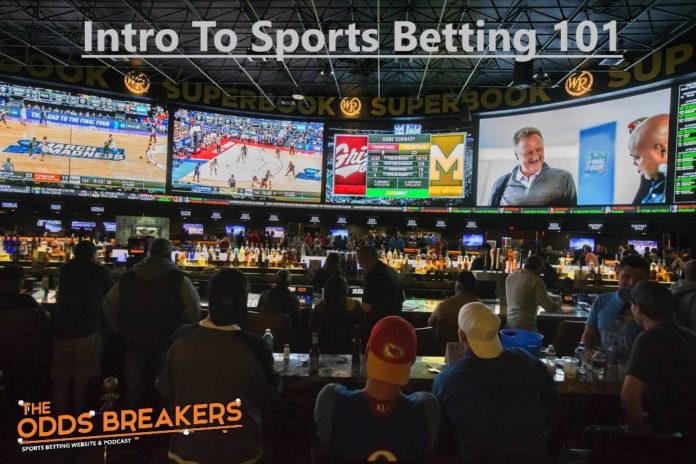We are currently in the wake of the legalization of sports betting across the United States and there is no better time than right now to go over some of the key disciplines to become (or remain) a success sports investor. Even the best players in this business have to remind themselves to stay disciplined and play with diligence to remain profitable rather than picking random sides just for the gambling fix while tilting after a bad day. The biggest mistakes that people make are betting past their limitations, playing for a need, and doing it with a much larger expectation. Any of those 3 mistakes make sports betting not only not fun, but they also make it much more consequential and irresponsible. The reason that people should sports bet is because of their love of sports more than their love of money. The great thing about sports betting is that you do not half to have a fan interest in either team for the game to be fun to watch and meaningful. Wagering on sports is the ultimate game within the game. Sports betting is a marathon and definitely not a sprint so loosen your belt, relax and enjoy the long ride.
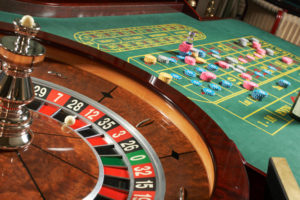
Have correct expectations: Some people come into sports betting with the misconception that it is easy to make a living doing it, they do not follow best practices making the game more like playing roulette. Trust me when I say that those lavish hotels and casinos that you see in Las Vegas did not build themselves on the fact that they give out tons of money. Over 90% of people who bet on sports come out losing on a yearly basis and less than 10% can say that they are truly profitable. As a matter of fact, the sharpest of all sports bettors are actually only around 56-60% accurate over their lifetime of sports betting and handicapping games. 56% feels low but it is actually very good at an average of laying -110 (betting $110 to win $100). The 10 in the -110 is the sportsbook’s take on your bet and also called the juice or the vig. The juice is how sportsbooks draw a profit in every single balanced line. In a perfect world for these books, each line would be about 50% accurate on each side and if exactly 50% of the sports bettors take one side of the line and the other 50% take the other side, the books will always be profitable due to the 4.54% average vig (-110). For the books it all evens out in the end and this is also the reason why we as sports bettors have to be better than ~52.38% rather than just 50%. But wait! Isn’t betting $110 to win $100 an almost 10% vig or more accurately, a 9.09% vig? No, it is actually almost half of that at 4.54% and here is why. Think of it as the total amount risked vs. the amount that the bookmaker keeps for themselves. An example of two bettors taking opposite sides of a bet, each bettor risked $110 for a total amount of $220. The winner would get $210 back; the $110 he put in to place the bet plus the $100 he won. The loser of course, receives nothing, so the bookmaker keeps $10, which is 4.54% of the total amount wagered. An average better will still win a lot of games so the book will be losing money minus the $10 some of the time (losing $100) and winning some of the time (gaining $110). So out of 100 bets, if the books win 47 bets they win $5170 (110×47) and if they lose 53 bets the books lose $5300 (100×53). You win some and you lose some and after time, the percentage that you need to win becomes 52.38%. Here is the formula that shows the book’s edge. Payout / (Payout + 100) = 110 / (110 + 100) = 110/210 = 52.38%. Ours is the same formula 100/210 = 47.62%. So you see that we must look at it as the sportsbook putting up money as well because they are essentially betting against you because THEY HAVE TO.
The House edge formula can be explained by looking at the hold/sum of all probabilities. In this case our implied probability of either side winning is 110/(110 + 100) * 100 = 52.38%. Again, it’s more than 100%, in this case 104.76%. The 4.76% represents the house hold, and works out to a house edge of 4.54%, evaluated by dividing the hold by the sum of all implied probabilities, or 4.76/104.76 = 4.54% which is the actual vig.
The reason why the sharpest sports bettors are only 56-60% accurate over time is because of the large variances that happen within a game such as officiating, play calling, coaching, momentum swings, fatigue, injuries, and the actual plays that are called and just flat out the way the ball bounces. As stated, a sports bettor must win at least ~52.38% of his/her bets in order to be profitable using a standard -110 (or 4.54% rake of the payout) juice and I will show you an example of why. To make it easy, we will bet 100 NFL games at -110 at $100 per bet and see what happens if we win 53% and 60% of those bets. At 53%, the profit of each bet at -110 is $90.90. Take $90.90 X 53 and the total take home is $4,817.00. Do not forget to minus out the 47 bets that we lost ($4,700.00) and the total profit for the season is $4,817 – $4,700 = $117.00. If we win 60% of those bets the number is $90.90 x 60 = $5,454.00 minus the $4,000 that was lost, the profit is $1,454.00. Barely enough for a months rent but still nice to be up 14.5 units! A $1000.00 bettor would be profiting $1170.00 at 53% and if he had that good 60% year, he profits at $14,540.00. So as you can see, sports betting for most people should be something done for incremental income or a long term investment rather than something one can expect to rely on as a main source of income. Being over 52.38% is very important at -110 lines and the more bets that are won, the more it compounds. For instance, a person who wins 60% of placing 50 bets makes less total money than somebody who wins just 55% of 150 bets. The more bets that can be made, the more profitable it is as long as you remain over ~52.38%. If the average vig is only 2.275% or -105 then you must hit over 51.22% This concept is similar to thinking that a guy who works at $20/hour for 10 years and then retires has made less than someone who works for $18/hour for 15 years. Now this doesn’t mean to run out and make a bunch of bets that have bad values because you could be only at 51% (a losing season) by not being careful with 500 bets rather than being at 58% with 350 better bets (Winning!). We will discuss implied odds, and estimated odds later in this article. If you do it right, you can win and beat these books!
Don’t show up late to class! After you read your sportsbook reviews from bettingbuck.com and follow the best practices in book selection, it is time to select where you want to spend your time shopping. One huge mistake that public bettors make is that they only choose just one sportsbook when there are many reasons to have multiple options. I do not know why anybody would limit themselves like this. This notion of only using one book is similar to doing only one exercise at the gym, only looking at one house to buy, only drinking one kind of beer, and shopping at only one grocery store. Using multiple books gives the sports bettor an extra edge from not only shopping the lines and getting the best numbers, but also it helps tell them that new information is out such as an injury that just has been made public or a large betting syndicate’s interest in a number. Every half point matters in this business in the long run so please do not sell yourself short.
Use proper bank roll management: Another huge mistake that the average square (not sharp) bettor makes is not properly appropriating his/her bankroll to weather the huge swings in sports betting. Some of the best bettors in the world can go on a streak of winning 7-15 or more bets in a row, and at the same time, they could lose 5-13 or more in a row. These streaks are unpredictable so who is to say that it won’t happen right when they start the betting season. When things are going bad, do take a couple days or a week (whatever you need) off occasionally. Trying to force plays is when most public players get sunk. They try to make it all back the next day over and over again. This poor method deviates them from what they originally set out to do and it usually ends badly. Like I stated earlier, you must remember the huge variances that exists in games. Even if you have a huge value on a game with a great number, it doesn’t mean that you necessarily are going to win that bet.

The best practice to manage your bankroll is to have the “unit” or “star” system meaning that each unit you play with is 1% of your bankroll. This method is especially important if you plan on betting consistently throughout the whole season. This means that if you start with a total of $100.00 in your bankroll, then your 1 star bet will be $1.00. If you start with $1000.00 then your average 1 star bet is $10.00. $10,000.00 is $100.00, $100,000 is $1000.00 and $1,000,000.00 is $10,000.00. I know these bet sizes sound small but we must remember that sports betting based on your own plays should be for pure recreation or long term investment and you should not put yourself in a situation that can be detrimental.
Don’t pay attention to what people say or what people are doing. Public bettors like to brag about how much they bet and you must remember that over 95% of them are consistently losing. You never have to talk about how much you placed on a bet and if people ask how much you have on the Bears game, you can tell them 2 units rather than saying $20.00 or $2,000.00 just the same. The amount of money that you place on your bets are literally none of anyone else’s business. Trust me when i say that it is much more enjoyable to not let a losing week phase your state of mind than bragging about how big your bets are. In order keep this fun and less stressful, you must incorporate these disciplines. In utilizing this system, I have seen people weather some really bad streaks draining their bank roll down to sometimes 30% early only to more than break even by the end of a season.
According to this star system, If you like a game just barely enough to make a bet then you should only play just 1 unit (star) and if you absolutely love a game and think that there is no way to lose the bet based on your estimated value, then your maximum bet should be 5 units or 5% of your bankroll. Your average bet size should be around 2-3 units during your season. Using this system based upon your numbers which is the estimated odds compared to the implied odds from the sportsbooks. The larger the discrepancy the larger the bet. Only use discretionary money in your savings, meaning if it all goes bye bye, then it will not affect your family, credit, happiness and lifestyle.

Know your key numbers: In most sports, and especially American ones, there are certain key numbers that have more value to you and more risk to the sportsbooks unless properly accounted for. The reason for this is because final scores tend to end on certain numbers more than they do on others due to the way the game is played and scored. For example in Hockey the most common total score is 5 due to a correlation between defense and the 3 ways you can get to 5 (1+4, 2+3 and 0+5). Being that there are so few points scored in Hockey, and especially in soccer, the smaller numbers are much more valuable and expensive to buy on and off of. An example of buying on or off of a number is paying the sportsbook 25 cents on the dollar to move from a -5 to a -4.5. Football key numbers are definitely the most significant due to how the game is scored and the amount of points scored per game. Being that most scoring is increments of 3 and 7, those two key numbers are definitely the most common, for example, games ending with final scores of 10-13 or 21-28. The key numbers in order of significance in the NFL are 3, 7, 10, 6, 14 and 4. Below is a sample taken from a sample from an article on Sports Insights of 2,670 NFL football games from 2003 to 2015 and here are the results which can be used as predictive probabilities that future NFL games end on these margins of victory or as we call them spreads.
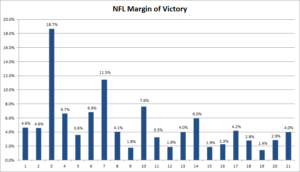
*see below for article
Being that key numbers are more prominent, and games end landing on these denominations more than not, the price to buy on or off of them is higher. To buy off of a 3 in NFL football it will cost you 25 cents on the dollar and to buy off of a 12 it will cost only 10 cents but that does not make it a good decision necessarily. Also keep in mind that in college football, the percentages on key numbers are not quite as large as the NFL due to a larger variation in final scores.
Know your expected values (EVs) within the numbers on each game: Expected value is (your chance of winning)*(your payout) minus (your chance of losing)*(your bet amount). I comprised a chart of implied winning percentages based on the spread below for NFL football. These numbers are called implied odds because it is based on an implied spread from the sportsbooks. Remember that we have to be correct on our bets on average over 52.38% of the time to be profitable. This means that bets with an expected value of over 52.38% can be played as long as there isn’t too many outlying factors such as injuries and bad spots. If your number on a football game is -5, and the sportbook’s number is also -5, then your expected value on taking a side in that game is exactly 50% which constitutes a no play (being below 52.38% due to the juice). As you see from the chart below, moving from a 0 to a 1 is a much smaller change in winning percentage than going from a -2.5 to a -3.5 due to the passing through a the key number of 3. If your number is at -11 on a game and the book’s number is a -12, then it would not be a smart play to make being that it only adds 1.32 (88.45 minus 87.13) percentage points to your expected value on making it a 51.32% EV. However, if the line moves to a -13.5 from your number at -11, you passed the threshold of 2.38 moving your EV to 52.84% (89.97 minus 87.13 plus 50). As long as there isn’t many outliers (injuries, trends or bad spots) this could be a play. The larger your deviation from 52.38%, the larger or more units your bet should be (max is 5). When it comes to key numbers, you should always at least look to bet both sides and I can explain more later in this article.
NFL Spread to Implied Winning Percentage
| Spread at -110 Vig | Team Implied winning % |
|---|---|
| 0 | 50 |
| -.5 | 50.63 |
| -1 | 51.25 |
| -1.5 | 52.5 |
| -2 | 53.46 |
| -2.5 | 54.48 |
| -3 | 59.37 |
| -3.5 | 64.27 |
| -4 | 65.77 |
| -4.5 | 67.26 |
| -5 | 68.1 |
| -5.5 | 68.95 |
| -6 | 70.65 |
| -6.5 | 72.35 |
| -7 | 75.21 |
| -7.5 | 78.06 |
| -8 | 79.14 |
| -8.5 | 80.21 |
| -9 | 80.66 |
| -9.5 | 81.11 |
| -10 | 83.56 |
| -10.5 | 86.02 |
| -11 | 87.13 |
| -11.5 | 88.24 |
| -12 | 88.45 |
| -12.5 | 88.67 |
| -13 | 89.32 |
| -13.5 | 89.97 |
| -14 | 92.42 |
| -14.5 | 94.87 |
Don’t show up late to class. Have a system: I can probably write multiple books on sports betting methods and systems, but I will try and keep it short for the sake of this article. When discussing this section it is important to define what a sports bettor is and what a handicapper is. A sports bettor is simply someone who bets on sports and a handicapper is someone who assigns advantage through numbers in order to even the odds of the outcome in a game. You do not have to be a handicapper to bet on sports and you do not have to bet on sports to be a handicapper. Being good at both certainly helps your chances of becoming profitable. Handicappers have a framework or a methodology of coming up with a number for their estimated odds to assign against the spread on a game. In sports like football and basketball, the most common way that good handicappers come up with a line (or a spread) is using predictive power ratings. Power Ratings are a system to develop a handicap in a game by ranking all the teams in one league from worst to first with a number assigned to that team representing the denomination on how my points better or worse they are from their peers. For example, if the Patriots are playing the Dallas Cowboys, you can predict the difference in points that the game will finish at. Say the Patriots are a 6.7 on your power rating and the Cowboys are a .9. If this game is being played on a neutral field like in London, your line on the game would be the Patriots favored by 5.8 points (6.7 minus .9). If the sportsbook line is the Patriots favored by 7 and their are no injuries, trends, bad match-ups or bad spots to account for, you might bet the Cowboys here based on the fact that you are coming off of a key number and went past the 6. According to my chart above, you would have at least 4.56 percentage points (75.21 minus 70.65) above 50% which is 2.18 percentage points in value (54.56 minus 52.38) which could constitute a play. In football and in basketball there are also points assigned for home field advantage. Each home field has it’s own number based on past performances but usually it is about 3 points and rarely over 3.5 or under 2.5. This means that if the Bears are playing the Packers in Chicago, and both teams are rated equal, then the Bears would be favored by 3 points and if the game was in Green Bay, the Packers would be favored by 3 points. The Handicappers that set lines for the sportsbooks factor this in just as you should when coming up with your number.
There are many different methods and ways that people use to create power ratings and nobody ever wants to give up the recipe to their secret sauce. In general, power ratings are created by a handicapper who assigns numbers to certain aspects of a team. For instance in football, a capper might assign a 5 for coaching, a 10 for QB/passing game, a 4 for rushing, a 7 for rushing defense, a 6 for special teams and so on. In order to create your own power ratings, you will have to have a vast knowledge of each team while updating your numbers on a daily basis. Creating and constantly keeping up on your own power ratings takes up a whole lot of your free time. For College football this could take up 3 or 4 hours of every Sunday morning during the season. If you haven’t tried to do this before, or you are pressed for time, I highly recommend using somebody else’s power ratings that are reputable. At least this way you can get your number without having to take a ton of time to put in the work and instead focus more on individual match-ups and situation spots. If you want to eventually start making power ratings yourself, you can use these public power rating numbers and compare them to your own. Some of the more reputable power ratings that I recommend are Teamrankings, Jeff Sagarin, Bill Connelly, and ESPN’s FPI. You can find these updated during the season early every week on the their respective websites. It is important to ask yourself if you trust yourself more than companies that do this for a living. Even the best handicappers compare their power ratings in case they missed something.
After you get your power rated number, you next have to look at things like injuries, individual match-ups, situational spots, and trends. When it comes to injuries, it definitely matters who it is at what positions in order to deduct the appropriate amount of points for each sport. In football it might take three starting offensive lineman to be listed as out in order to affect your power rating by 1 point, yet when it comes to quarterbacks, you may have to adjust your power rating by up to even 11 points depending on who it is. For example, Deshawn Watson over the last two years was worth 8 to 10 points to the line and that was made obvious when he didn’t play. When factoring in injuries, we also must remember to give back points depending on how good the backup player is to that position. Laveon Bell could have been a larger difference when he sat out for the Steelers last season if it wasn’t for the good play of James Connor. Looking at individual match-ups is also very important to a handicap. You might have two teams power rated very closely together, but one of those teams might be great on offense and pass-defense but so bad against the run that they will rarely possess the ball and get clocked most of the game without being able to stop the other team that can rush the ball. Looking at these match-ups may not only take you off of a play, but it also can swing you so much that you start to like the other side of the play (betting on the other team). Remember that sportsbooks, just like you, also may have factored in the match-up adjustment to these lines so make sure to always question your number and compare your results with your sharper peers. Situational spots are also very important to the handicap. Schedule is definitely something that cappers will adjust for. In Basketball, sometimes you will catch a team that played less than 2 days before and could be tired while the other team is rested. In football, the Thursday night and Monday night games either give teams a shortened week or extra rest. In some sports, the rest may be so long that teams could come in rusty and it is always good to fade them in the first half. Travel is also very important. If a team has multiple away games and/or is traveling the different time zones, the time changes and the mental fatigue can definitely take a toll. Cappers generally adjust anywhere from 0 to 3 points on the power rating depending on the team and the schedule spot. Lastly, there is the look ahead and the let down spots to factor in. The look ahead is when a good/great team is looking past an inferior team to the next game against another great team, a rival, competitor or divisional opponent. The good handicapper would look to bet the dog in this spot. Finally we need to look at trends. Maybe a quarterback has a history in playing bad in cold weather. Maybe there is a stadium that favors unders. Maybe there is a coach that always gets the best of a good team. Trends are hard to assign an actual number to but something you should at least pay close attention to. In football, I tend to take them seriously and especially if there is the same coach and/or quarterback. It is always best to ask yourself why when noticing a trend so that you can learn from it in the future.
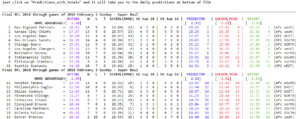
**see below for reference
The last way that I am going to discuss some handicapping techniques is the use of algorithms to come up with a final score. An algorithm (pronounced AL-go-rith-um) is a procedure or formula for solving a problem, based on conducting a sequence of specified actions. An every day example of an algorithm is a cooking recipe. The ingredients are the data and the mixing with the baking is the mathematics. An algorithm is really nothing more than a function with changing variables. Being that the match-ups and the stats differ from week to week, you will always get different variables and predictive values for the final score. Some of the stats used in the NFL are Yards per game on offense and defense, yards per point, penalty yards and more. For basketball, some of the stats are team efficiencies on offense and defense and pace of play. To me, algorithms can paint a great picture with everything held equal, but they definitely have their limitations due to most of them not factoring in individual match-ups and most of all, many of them do not do a great job in factoring in strength of conference/division or schedule like power ratings do. I certainly like to use algorithms for totals predictions due to the use of pure numbers and statistics. I use algorithms for football and basketball, but I do rely a lot more on individual power ratings especially for betting ATS (against the spread).
Don’t get sucked into stupid plays with bad EVs: Remember when I said that those casino’s didn’t build themselves? It takes lots of people losing a lot of money to do this and as smart players, it is our job to beat these books. Don’t bet on pure emotion and do not get sucked into stupid plays that favor the sportsbooks. Many people like to play parlays because it is very fun to watch their money multiply by winning multiple bets. Betting a 3 game parlay pays 6-1 in most books and people love to get that fat return. The problem with 6-1 is that it isn’t actually a good payout for what they are risking. Let’s look at the math. To figure out the chances of hitting a 3 game parlay, if we assume the books are perfect on the spread, (50% chance of each side hitting) you must multiply .50 x .50 x .50 which equals 12.5%. It is basically the same chances of flipping a coin three times in a row getting and heads every single time. Now, to figure out what your payout would be without the juice, you take 1/.125 which equals 8. Minus out your unit that you would be paid back (1 that you would make back) and you are at 7. This means you should be payed at 7-1 to accomplish this feat. Being that the sportsbooks only pay you 6-1 means there is a good 16 cents per dollar of juice (7/6 = 1.16) unless you are assuming a money-line rollover which compounds your bets which makes it close to -110. Even if you think that you have a huge edge on your three bets, you must remember that even the best sports bettors are only 56-60% lifetime because that there is a lot of variance in these games. Look at it this way, if you made 3 bets a week would you rather have 1 parlay needed all 3 or 3 individual plays. Ask a 58% bettor that question. Now don’t get me wrong, parlays are FUN and even I play them from time to time such as during the NCAA tournament and college bowl games, but I do not bet as much as I bet a normal game and I only use a separate amount of additional discretionary income (fun money). Playing parlays to me are kinda like playing the power ball and should not be done often unless you can find a great correlation within the same game. Future bets on the other hand can be extremely profitable if properly played. I have seen books favoring a team at 20-1 to win the national championship while others have it at 90-1. Remember to shop these books and read up on them before you make your plays. What I love about division, conference and championship futures bets, is that if you feel you know something more than the books, and are correct, you can accomplish a massive payout. If Wisconsin has a better than 10% chance to win the Big 10, then it may be a smart bet to take them at 14-1. (1/14*100 = Sportsbooks saying the Badgers have a 7.4% chance of winning the big 10). Another thing that I love about futures is the ability to hedge out of them. Anyone with a 50-1 Michigan future ticket in the 2018 NCAA Mens basketball championship would have been smart to bet Villanova at 15 times the amount of their 50-1 Michigan play ;-). I also like to play season win totals. The sportsbooks will predict a total number of wins that a team will have for the season and we can either agree by not placing a bet or bet over or under in that total. Playing a season win total spreads out the variance throughout a whole season rather than one game. When Clemson had that bad loss against Syracuse in 2017, they still went 11-1 in the ACC and cashed some nice over 10.5 season win total bets. Always remember to check strength of schedule when researching these plays. The downside to betting futures and season win totals is that the sportsbooks hold on to your money for the full season without paying interest. If you are willing to make the investment, then make sure you are okay with them holding your money.
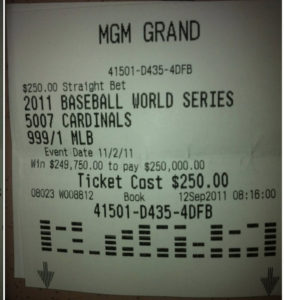
Is it okay to buy a half point? Well that really depends on what kind of a situation you are in, but the general answer is no. In football, buying random points on or off of non-key numbers cost about 10 cents, but when you buy on or off of key numbers it can be as high as 25 cents such as the 3 and the 7. There is a simple calculation that you can use to tell you if/when to buy off of these numbers and to show you the appropriate prices. That calculation is x/(1-x) multiplied by -100 where X is your 52.38 plus the difference in implied winning percentage. We have to start at 52.38 (-110) because that is where the line starts us out to become profitable. Looking at my chart from above, we can see that going from -2.5 to -3 is a 4.89 (59.37 minus 54.48) percentage point difference. Take 4.89 + 52.38 and it equals 57.27%. .5727/(1-.5727) * -100 = -134. So this would be -134 meaning that it is worth 24 cents (134 minus 110) to buy a half point to -3. Sportsbooks charge 25 cents for this move so you can see it is just barley not worth it to make this individual play. If you do this calculation to go from +1 to +1.5 you can see that the number is -115.6 making the 10 cents not worth it here either. If you take the sample NFL chart from Sports Insights above you can get close to the same number by taking almost half of the 18.7% points on the 3 (take 59% of 18.7 = 11 because that is the chance of “your 3” winning according to the probability. The 3 will land on the other side 41% of the time). and then take half of that being that is a half point that you are buying, and you get 5.5 which from this sample size is somewhat close to my chart at 4.89. Being that is just a sample, I am going to stick with the chart. The few times that I can find it worth it to buy a half point off of a key number is if you are trying to middle when the math works out for you. I personally would rather just try and shop for a better number using multiple books from the information that you can get from bettingbuck.com. Another important thing to keep in mind is that college football has the same key numbers, but they are less impactful than the NFL because the variance in the spreads and final scores can range much farther making the standard deviation of the final scores much larger. The price point to make it worth buying off of a 3 in college football is 15 cents compared to the NFL’s 24 cents. Remember that if you use multiple books and if you get a +3.5 at -110 and a -2.5 on the same game at -110, there is a greater than 9 percent chance that the number lands on a 3 where you can double up, and if it doesn’t land on a 3, then you only lost 4.54% of your money. Over time this play will make more money than it loses due to that at least 9% (going by the Sports Insights chart) of the time that you are doubling your return (18%/2 for your side then factor in the 59% chance your 3 hits and not the other side. .59/.50 *18/2 = 10.62 ) and the 89.38% (100 – 10.62) of the time you are only losing 4.54% of your total play of 2 units. For example, $100 bet on each side ($200 total) is payed $190.90 if it lands on a any other number except 3. For a $100 bettor, out of 100 of these plays, you would win $90.90*2*10.62 wins = $1,930.72 and you would lose $4.54*2*89.38 losses = $813.57. So $1,930.72 minus $813.57 = $1,117.15 worth of profit. Even if at buying 10 cents each side (if possible) of the key number of 3 is profitable in the long run (as long as your 3 comes up 9% or more times). Any questions??? Use multiple books people!
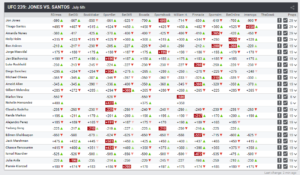 ***See below for reference
***See below for reference
Timing is everything! Timing is huge when it comes to sports betting and betting stale lines will not lead to to success. When you get good at this you can actually start to be able to predict the line moves and be a lot more strategic in your plays. Best practices are to make your bets right when the lines come out as well as right before the games start. Let’s not kid ourselves here, sportsbooks are wrong coming out with a line plenty of times just like we all differ in our numbers and power ratings. These books have to put lots of lines on many sports out every day while we can stay focused on one sport and even one conference. By placing your bets right when the lines come out, you have the early advantage to find weaknesses in the numbers and hit them before people catch on forcing the lines to move. This strategy is great for over 95% of the players out there that do not make large limit bets. Sportsbooks do not raise the limits into the 4-5 figure range until the middle or end of the week for football. Even books know that they can leave themselves exposed with high limit openers. They instead will let the sharper lower limit players make plays early thus creating more of an honest line due to the movement for the middle of the week. Mid-week is the time that you do not want to make your bets because in general, the lines have been adjusted correctly for the most part (maybe a few might be missed). The next wait is for the general public to make their plays up to minutes to hours before the game to adjust the next line correction and hopefully open up some more plays for you to cash in on. At this point, the sportsbooks do not even necessarily care if they are wrong on the numbers because they are mainly trying to just balance their action to profit on both sides of the lines. You can in most cases find some good numbers that were not there before by just waiting it out thus giving you an edge based on your expected values derived from the estimated odds in your power ratings. These line moves are also especially good for derivative betting (first quarter and half-time) when you know which teams start slow and which teams start fast. These are the techniques and strategies that it takes to be successful in this business, and once you get the hang of it and play with discipline, you can become or remain profitable.
Remember to have fun: Like I have stated before, sports betting and handicapping games is a marathon and not a sprint. If you feel that it takes way to much time to be successful, then there is no shame in purchasing plays from professionals if not only to compare them to your own numbers, but to also profit off of those plays as well. These Cappers will also tell you on how they arrived to that play in many cases so you can learn from it in order to do some handicapping of your own in the future. Another less time consuming way to have fun capping lines is to just focus on one division or conference and get really good at just handicapping that. Try and make some friends who can focus on other conferences and have a meeting of the minds before each game and boom, you have your own betting syndicate! Try and remember some of the disciplines that I explained during this article and you will be able to weather the storm when it comes to bad streaks as well as reap the profits when it comes to good ones all while having a great time enjoying each game. Should you have any questions, please feel free to tweet me @theoddsbreakers. Have a fantastic time and go get some winners!
Kiev O’Neil
* Travis from Sports Insights, “why are key numbers so important in betting” https://www.sportsinsights.com/blog/why-are-key-numbers-so-important-in-nfl-betting/
January 13th, 2015
**http://sagarin.com/sports/nflsend.htm
***https://www.bestfightodds.com/

